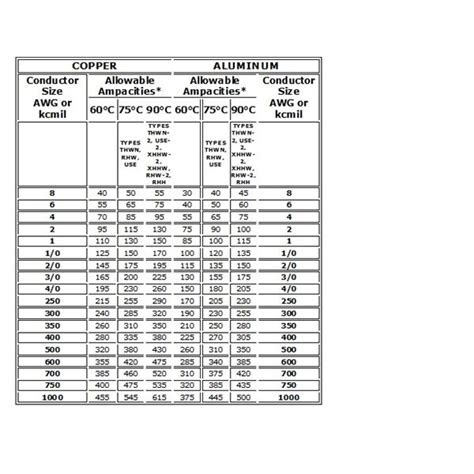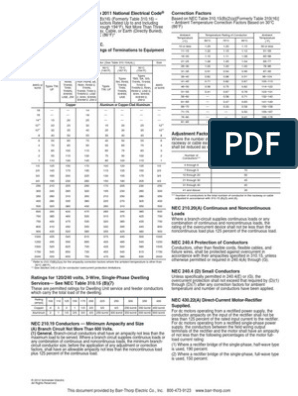Nec 310.16 Table
If you work in the electrical industry, you likely already know that the National Electric Code (NEC) is a collection of standards that govern the safe installation of electrical wiring and equipment in the United States. But did you know that one of the most important parts of the NEC is Table 310.16, which provides information on ampacity, or the maximum amount of electrical current a conductor can safely carry?
Whether you're an electrician, engineer, or just someone who wants to understand the basics of electrical safety, it's important to understand how Table 310.16 works and how to use it properly.
So, what exactly is the purpose of NEC Table 310.16? Simply put, it provides guidance on how to choose the right size wire or cable for a given electrical load. The table takes into account factors like wire type, insulation material, and ambient temperature to determine the maximum current that a specific wire size can safely carry without overheating and causing a fire or other electrical hazard.
If you've ever worked with electrical wiring, you probably know that choosing the wrong size wire can be a costly mistake. Undersized wire can overheat and possibly start a fire, while oversized wire can be unnecessarily expensive and difficult to install. That's where NEC Table 310.16 comes in - it helps you choose the right size wire for the job, preventing both safety hazards and unnecessary expenses.
My Personal Experience with NEC Table 310.16
As an electrician, I rely on NEC Table 310.16 on a daily basis to ensure that my wiring installations are safe and up to code. One particular job that comes to mind is when I was working on a residential remodel project. The homeowner wanted to add a new hot tub to their backyard, which required a dedicated electrical circuit. Using NEC Table 310.16, I was able to determine the appropriate wire size and breaker size to safely handle the load, preventing any potential hazards and ensuring that the hot tub operated smoothly.
The Target of NEC Table 310.16
The target audience for NEC Table 310.16 includes electricians, electrical engineers, and anyone else involved in electrical installations, repairs, and maintenance. The table is designed to help these professionals make informed decisions about wire size and current capacity, ensuring that electrical systems operate safely and efficiently.
How to Use NEC Table 310.16
Using NEC Table 310.16 is relatively simple, but it does require some basic knowledge of electrical concepts. To use the table, you'll need to know the maximum current draw of the electrical load you're working with, as well as the type of wire and insulation you're using. Once you have this information, refer to the appropriate section of the table to determine the minimum required wire size for your application.
It's important to note that NEC Table 310.16 is just a guideline, and there may be other factors that need to be considered when choosing wire size and capacity. Always follow all applicable electrical codes and regulations, and consult with a qualified professional if you have any questions or concerns.
Navigating NEC Table 310.16
NEC Table 310.16 is divided into several sections, each of which corresponds to a different type of wire or cable. For example, there are sections for copper conductors in free air, copper conductors in conduit, and aluminum conductors in conduit, among others.
To find the appropriate section of the table for your situation, you'll need to consider the type of wire you're using as well as the installation method. Once you've found the right section, you can use the ampacity values listed to determine the maximum current capacity of your wire at a given temperature and in a given installation configuration.
Tips for Using NEC Table 310.16
To get the most out of NEC Table 310.16, it's important to keep a few key tips in mind:
- Always use the appropriate wire size and capacity for your particular application.
- Consult with a qualified professional if you have any questions or concerns about your wiring installation.
- Make sure to follow all applicable electrical codes and regulations.
- Regularly check your wiring installations for signs of wear, damage, or other potential hazards.
Question and Answer
Q: What is the maximum temperature that NEC Table 310.16 considers when determining ampacity?
A: NEC Table 310.16 takes into account a maximum temperature of 90°C for most wire and insulation types. However, some specific types of wiring may have different maximum temperature ratings.
Q: What is the difference between ampacity and current capacity?
A: Ampacity and current capacity are essentially the same thing - they both refer to the maximum amount of electrical current that a conductor can safely carry without overheating or otherwise becoming damaged. Ampacity is the term more commonly used in the electrical industry.
Q: Is it ever okay to exceed the ampacity ratings listed in NEC Table 310.16?
A: No, it is never safe to exceed the ampacity ratings listed in NEC Table 310.16. Doing so can put you and others at risk of electrical shock, fire, or other hazards.
Q: Can I use NEC Table 310.16 to determine wire size and capacity for low-voltage applications?
A: No, NEC Table 310.16 is only intended for use with wiring and cables that operate at voltages of 50 volts or higher. For low-voltage applications, consult with a qualified professional or refer to the appropriate voltage-specific wiring guidelines.
Conclusion
NEC Table 310.16 is an essential tool for anyone working in the electrical industry. By providing guidance on wire size and current capacity, the table helps ensure that electrical systems are safe, efficient, and up to code. Whether you're an electrician, electrical engineer, or just someone who wants to understand the basics of electrical safety, understanding how NEC Table 310.16 works is an important step in becoming a knowledgeable and responsible practitioner.
Gallery
Nec Wire Ampacity Table 31016

Photo Credit by: bing.com / nec ampacity
310 16 Nec Table - Micro Wiring

Photo Credit by: bing.com /
1) A 240 V, 40 A, Single Phase Load Is Located 150 Ft | Chegg.com

Photo Credit by: bing.com / 310 nec conductor phase sizing hasn
Nec Table 310 16

Photo Credit by: bing.com / nec
Ampacity Table 310.16.

Photo Credit by: bing.com / nec ampacity overcurrent
0 Response to "Nec 310.16 Table"
Post a Comment